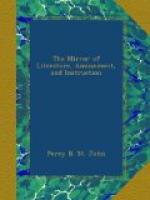“Sung the Seasons and their change.”
England can likewise boast of very great names who have been attached to this art, though they have not written on the subject. Lord Burleigh, Sir Walter Raleigh, Lord Capell, William III—for Switzer tells us, that “in the least interval of ease, gardening took up a great part of his time, in which he was not only a delighter, but likewise a great judge,”—the Earl of Essex, whom Lord William Russell said “was the worthiest, the justest, the sincerest, and the most concerned for the public, of any man he ever knew;” Lord William Russell too, who, as Switzer tells us, “made Stratton, about seven miles from Winchester, his seat, and his gardens there were some of the best that were made in those early days, such indeed as have mocked some that have been done since, and the gardens at Southampton House, in Bloomsbury Square, were also of his making.” Henry, Earl of Danby, the Earl of Gainsborough, “the Maecenas of his age,” the Earl of Halifax, the friend of Addison, Swift, Pope, and Steele; Lord Weymouth, of Longleate; Dr. Sherard, of Eltham; the Earl of Scarborough, an accomplished nobleman, immortalized by Pope, and by the fine pen of Chesterfield; and the Duke of Argyle, with numerous other men of rank and science, have highly assisted in elevating gardening to the station it has long since held.[6]
[6] “Portraits of English Authors on Gardening.”
Beauty and health are the attributes of gardening. In illustration of the former, we remember a passage from Gervase Markham, thus: “As in the composition of a delicate woman the grace of her cheeke is the mixture of red and white, the wonder of her eye blacke and white, and the beauty of her hand blew and white, any of which is not said to be beautifull if it consist of single or simple colours; and so in walkes or alleyes, the all greene, nor the all yellow, cannot be said to be most beautifull; but the greene and yellow, (that is to say the untroade




